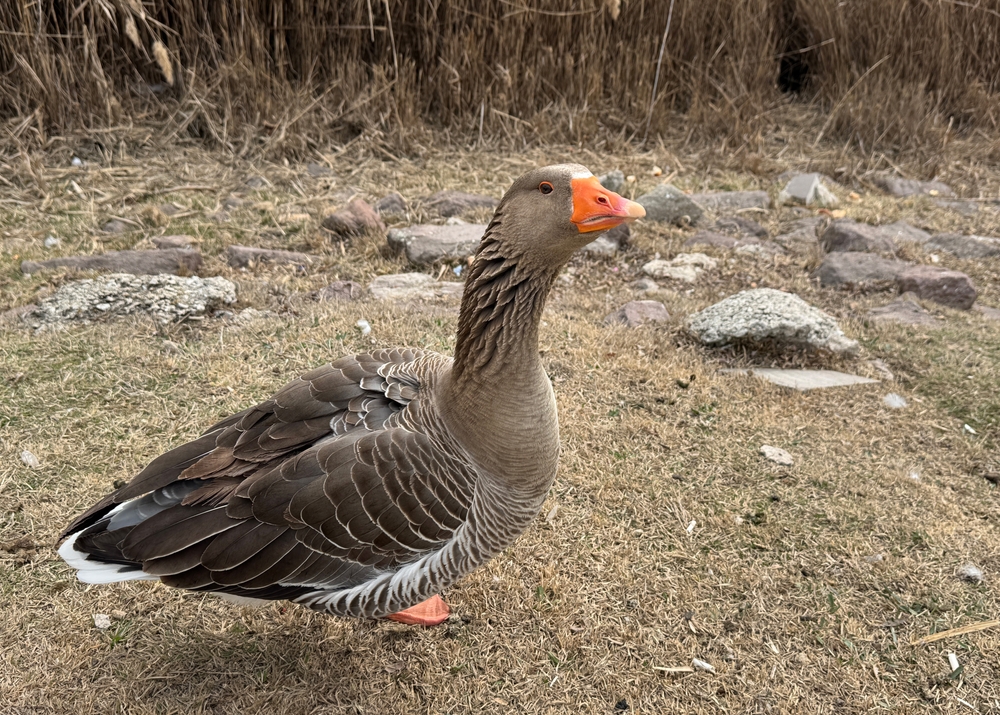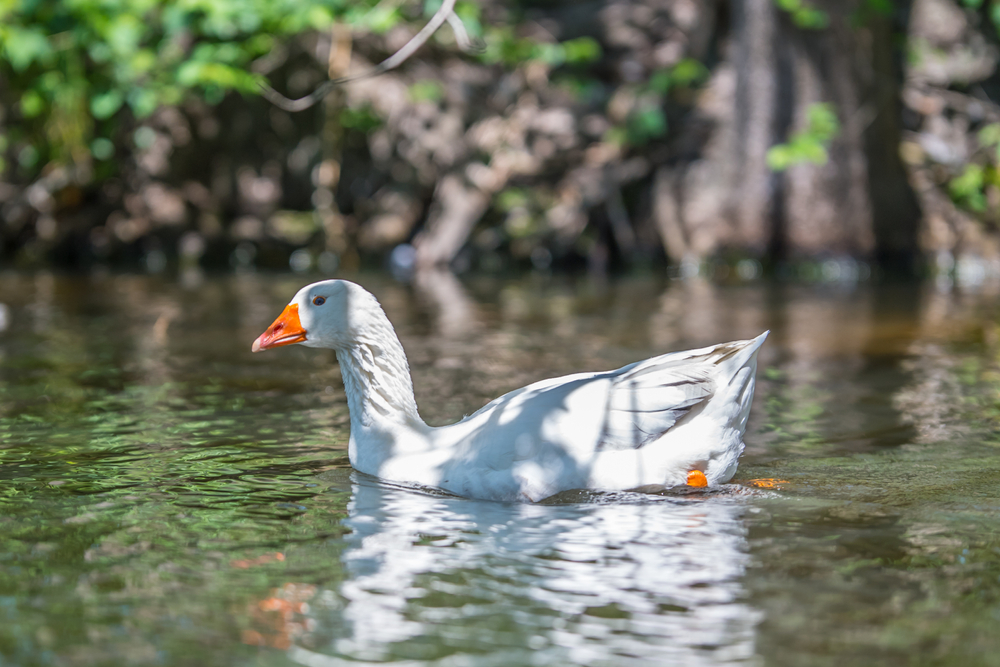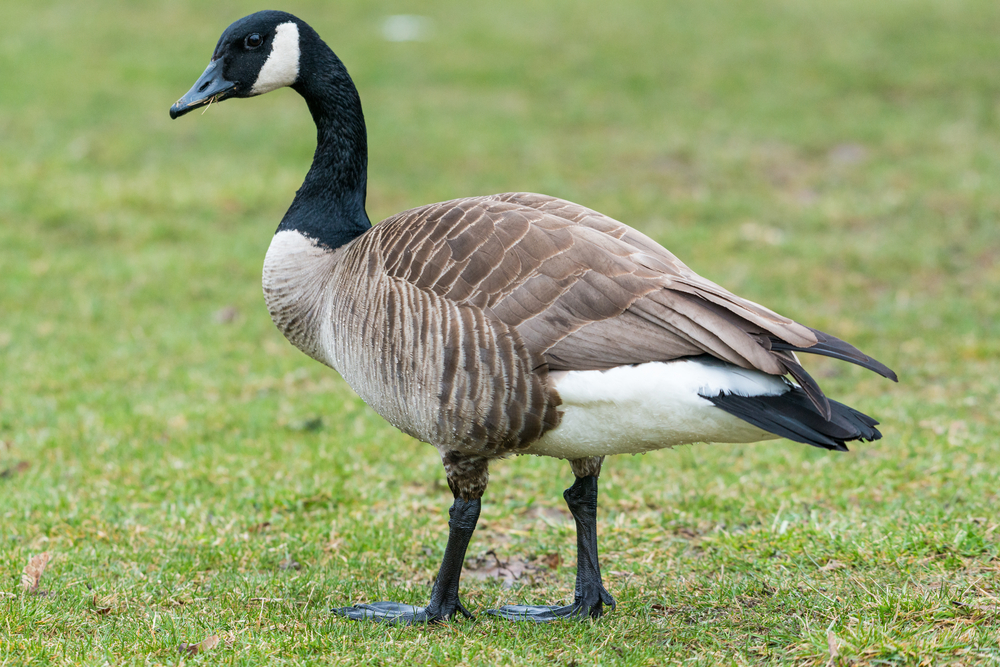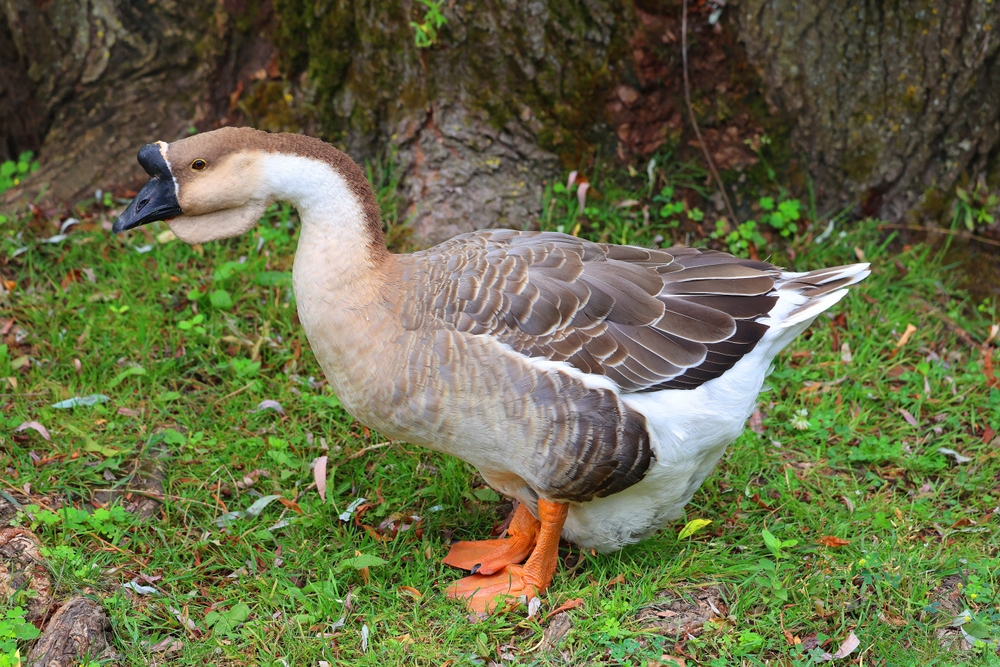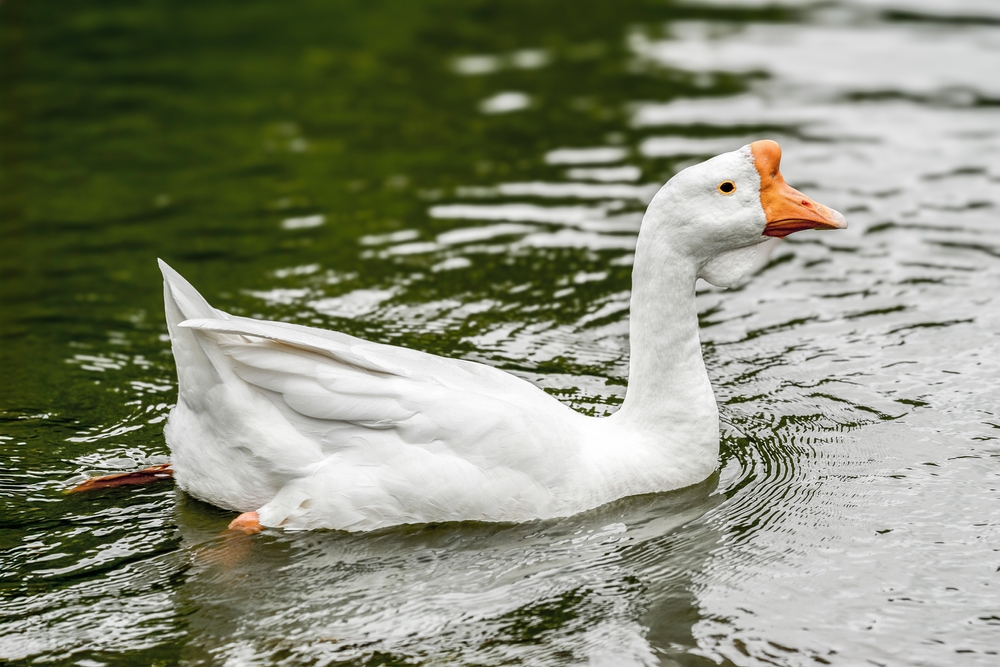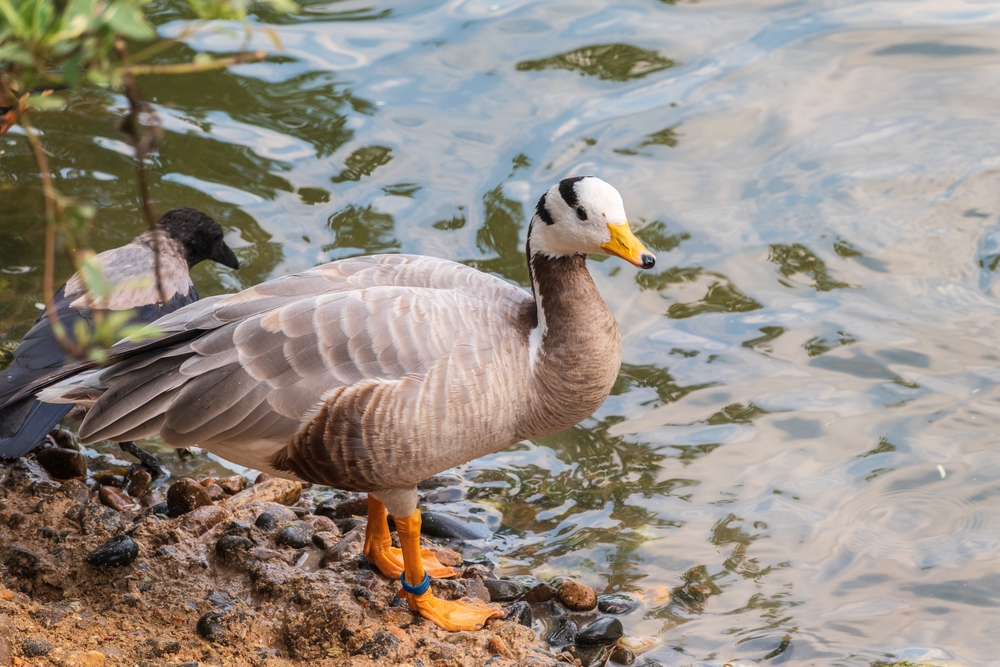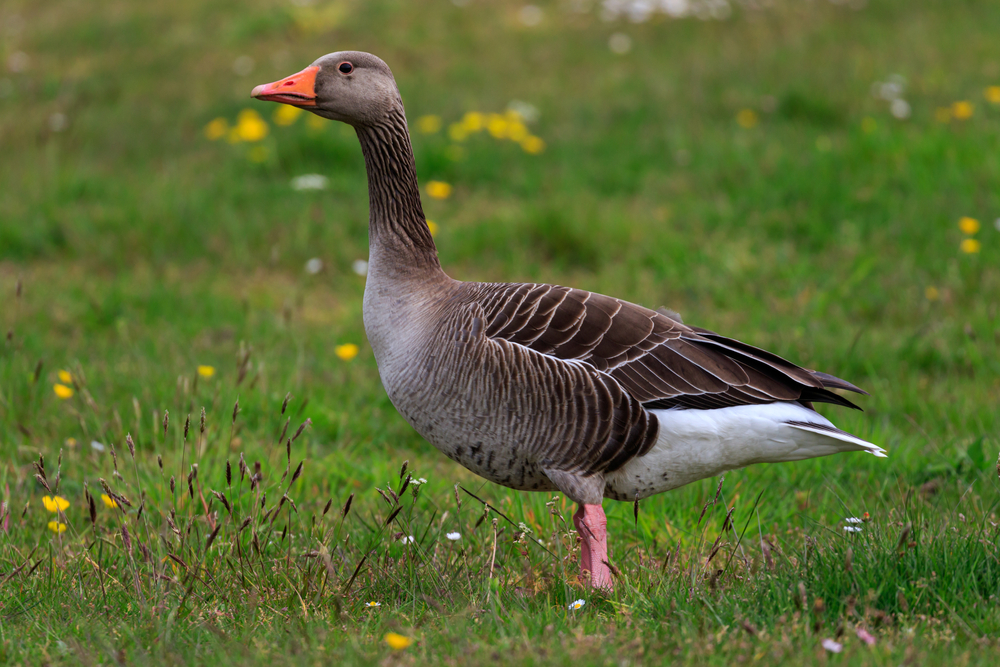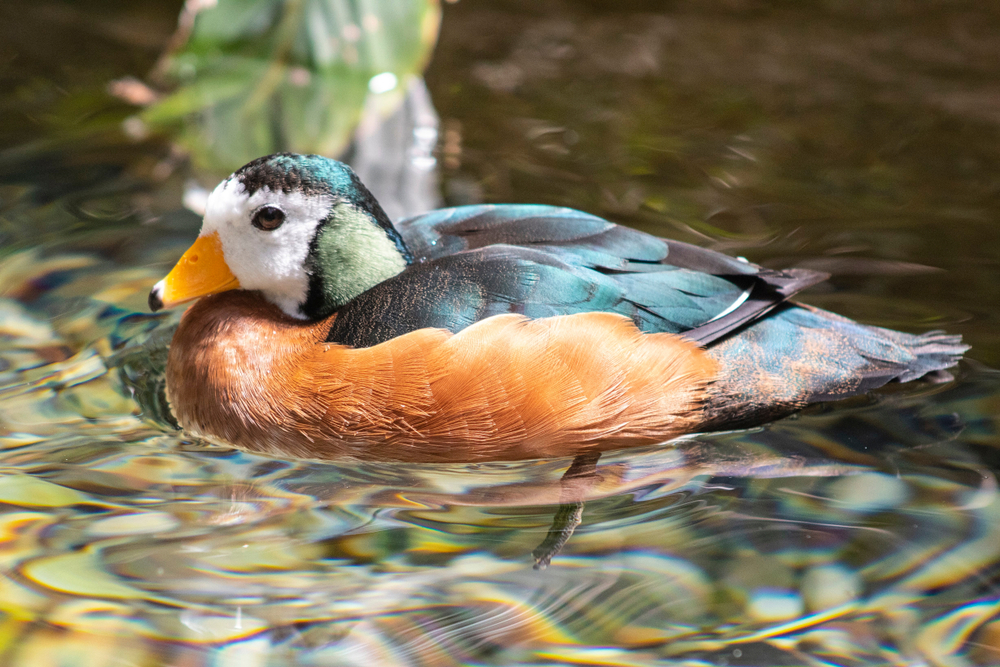The Toulouse Goose is a domestic breed directly descended from the Greylag Goose (Anser anser), making that species its closest wild relative.
About
The Toulouse Goose (Anser anser domesticus) is a large domestic breed of the Anatidae family, developed in southern France near the city of Toulouse. Descended from the wild Greylag Goose (Anser anser), it is one of the heaviest and most distinguished goose breeds, historically prized for meat, foie gras production, and down feathers. Today, it is also admired as a show bird and as a calm, stately addition to farms and homesteads.
Toulouse Geese are among the largest domestic geese. Ganders typically weigh 9 to 11 kilograms (20 to 24 pounds), while females average 7 to 9 kilograms (15 to 20 pounds). Exhibition strains, bred for shows, can be even heavier. They are easily recognized by their broad bodies, low carriage, and full paunch. Their plumage is usually soft grey with lighter shading underneath, orange bills, and orange legs. A prominent dewlap—a fold of skin under the bill—is characteristic of many strains, particularly the exhibition type.
This breed is slow-maturing but produces rich, high-quality meat and excellent fat for foie gras. They are moderate egg layers, producing 20 to 40 large white eggs per year, though productivity varies by strain. Toulouse Geese are efficient grazers, feeding mainly on grass and weeds, but they require supplemental grain if raised for rapid growth or weight gain.
Known for their calm, docile nature, Toulouse Geese adapt well to farm life and are generally less noisy than other breeds. They are not particularly good flyers, making them easy to manage in open areas. With proper care, they can live 15 to 20 years.
The Toulouse Goose remains a symbol of traditional European goose keeping, combining beauty, utility, and gentle temperament in one of the most iconic heavy goose breeds.
Physical Characteristics
The Toulouse Goose is a heavy, broad-bodied domestic breed developed in France, renowned for its large size, soft gray plumage, and utility as a meat and foie gras bird.
Plumage: The plumage is primarily soft gray, with lighter shades on the breast and belly and darker gray on the back and wings. The feathers are loose and fluffy, giving the breed a rounded, massive appearance.
Head & Beak: The head is large and broad, with a stout orange to pinkish-orange bill. Eyes are brown, set in a relatively short face. Some strains (particularly exhibition Toulouse) may have a dewlap under the bill.
Body & Neck: The body is extremely broad, deep, and heavy, with a deep chest and prominent keel. The back is long and flat, and the abdomen often has pronounced folds of fat. The neck is thick, moderately long, and slightly arched. Legs and feet are short, sturdy, and orange.
Size:
-
Length (Body and Tail): 30–37 in (76–94 cm)
-
Wingspan: 5.0–6.0 ft (1.5–1.8 m)
-
Tail Length: 6–7 in (15–18 cm)
Weight:
-
Adult Male (Gander): 20–26 lbs (9–12 kg) in utility strains; up to 30+ lbs (14 kg) in exhibition strains
-
Adult Female (Goose): 16–20 lbs (7–9 kg) in utility strains; up to 20+ lbs (9+ kg) in exhibition strains
Strains:
-
Production Toulouse: Medium to large, bred for egg and meat output, without exaggerated dewlaps or keel folds.
-
Exhibition Toulouse: Heavier and broader, bred for show, often with a large dewlap and double abdominal lobes.
The Toulouse Goose’s combination of immense size, soft gray plumage, and heavy body structure makes it one of the most distinctive and valuable domestic goose breeds.
Reproduction
The Toulouse Goose is a large domestic breed with reliable breeding ability, though its heavy body and selective breeding for size can affect fertility compared to lighter goose breeds.
1. Mating and Courtship:
Toulouse Geese are generally monogamous, though one gander may service multiple females in farm settings. Courtship includes honking, head bobbing, and protective displays by the male. Due to their heavy size, careful management of breeding pairs improves mating success.
2. Breeding Season:
Breeding begins in late winter to early spring (February–April), though in managed environments, the season may extend with supplemental lighting and feeding.
3. Nesting:
The female builds a nest on the ground in a sheltered area, lining it with straw, grasses, and down plucked from her breast. Farmers often provide nest boxes or secluded corners for protection.
4. Egg Laying and Incubation:
A typical clutch consists of 20–35 large white eggs per season, though exhibition strains tend to lay fewer due to their bulk. Incubation lasts 28–35 days, performed by the female, while the gander guards the territory.
5. Hatching and Gosling Development:
Goslings hatch with soft yellow down, weighing 3–4 oz (85–110 g). They are precocial, walking and grazing soon after hatching, guided by their mother. Parents are attentive, and the male often helps guard the young.
6. Growth and Fledging:
Young Toulouse Geese feather out by 8–10 weeks and are ready for independence by 12–14 weeks. Their rapid growth has made them popular for meat production.
7. Sexual Maturity:
Toulouse Geese reach breeding age at about 2 years, though some females may begin laying as early as 1 year under good conditions.
The Toulouse Goose’s combination of steady egg-laying, devoted parental care, and rapid gosling growth makes it a valued domestic breed, though its size requires careful breeding management.
Lifespan
The Toulouse Goose is a hardy and long-lived domestic breed, though its lifespan depends heavily on care, strain type, and whether it is raised for production, exhibition, or companionship.
Lifespan in the Wild (Ancestor – Greylag Goose):
The wild Greylag Goose (Anser anser), from which the Toulouse is derived, typically lives 10–15 years, with some surviving up to 20 years.
Lifespan in Domestication:
Toulouse Geese generally live 15–20 years with proper care, secure housing, and balanced nutrition. In excellent conditions, some individuals have been known to reach 25 years or more. Exhibition strains, being heavier, may have shorter lifespans due to obesity and related health issues.
Threats to the Toulouse Goose:
-
Predation: Foxes, raccoons, coyotes, stray dogs, and raptors pose risks if geese are not securely housed.
-
Health Issues: Obesity, bumblefoot, and respiratory problems are more common in heavier exhibition strains.
-
Environment: Poor shelter, unsanitary water, and lack of grazing access reduce life expectancy.
-
Human Use: Many Toulouse Geese raised for meat or foie gras are harvested at a young age, far earlier than their natural lifespan.
Conservation and Care:
To ensure longevity, Toulouse Geese require secure enclosures, grazing pastures, clean water, and veterinary care. Their calm temperament and manageable nature make them suitable for long-term companionship as well as farm production.
Eating Habits
The Toulouse Goose is primarily herbivorous, with feeding habits adapted for both grazing and farm management. Its large body size means it requires greater food intake than lighter breeds.
Diet:
They consume grasses, clover, aquatic plants, grains, and root vegetables. On farms, their diet is supplemented with corn, oats, wheat, barley, and commercial waterfowl feed. Leafy greens such as lettuce, cabbage, and spinach are readily accepted.
Foraging Strategy:
Toulouse Geese are dedicated grazers, spending much of their day cropping grass. Their broad, powerful bills allow them to shred vegetation efficiently. When allowed access to pastures, they reduce feed costs and contribute to natural weed control.
Feeding Behavior:
They are social feeders, grazing in groups for much of the day. Clean water is essential for drinking and for rinsing their bills during feeding. Because of their large size, they are slower movers compared to lighter breeds, often grazing more steadily than actively.
Human Feeding Practices:
Farmers often provide grain rations to supplement pasture, especially in winter. In foie gras production, Toulouse Geese may be subject to force-feeding (gavage), though this is limited to specific regions and controversial. Care must be taken to prevent obesity, especially in exhibition strains.
Seasonal Feeding:
-
Spring and Summer: Fresh pasture grasses, clover, weeds, and aquatic vegetation.
-
Autumn and Winter: Stored grains, hay, and root vegetables such as carrots or beets.
Ecological and Practical Role:
Toulouse Geese are valued for their efficiency in converting forage and supplemental grain into body mass. They are also used in orchards and fields as natural weed control.
The Toulouse Goose’s large appetite, steady grazing behavior, and adaptability to both free-range forage and supplemented diets make it one of the most practical yet demanding domestic goose breeds.
Uniqueness
The Toulouse Goose is among the most distinctive and historically significant domestic goose breeds, known for its size, calm demeanor, and agricultural importance:
Massive Size: One of the heaviest goose breeds in the world, Toulouse Geese can exceed 25–30 lbs (11–14 kg) in exhibition strains, making them prized for meat production.
Exhibition vs. Utility Strains: There are two distinct types—Production Toulouse, bred for farm utility with fewer exaggerated features, and Exhibition Toulouse, bred for shows, with enormous body size, deep keels, and sometimes a prominent dewlap.
Gray Plumage: Their soft, smoky-gray plumage with lighter underparts sets them apart from white domestic breeds like the Embden Goose, giving them a dignified, almost regal appearance.
Foie Gras Legacy: In France, the Toulouse Goose became historically associated with the production of foie gras, due to its natural tendency to gain weight quickly and efficiently.
Calm and Docile Temperament: Unlike more aggressive domestic breeds, Toulouse Geese are known for being gentle and quiet, making them easier to manage despite their size.
Heritage Significance: Developed in the Toulouse region of southern France centuries ago, they represent one of the most influential goose breeds in European farming history.
Longevity in Use: Beyond meat and egg production, their feathers and down have long been valued for bedding and insulation, adding to their importance as a multipurpose breed.
The Toulouse Goose’s combination of immense size, calm temperament, and historic agricultural role make it one of the most iconic and unique domestic goose breeds in the world.
Be the First to Share Photos of This Species.
FAQ’s
1. What is the closest species to the Toulouse Goose?
2. How does the Toulouse Goose compare to other geese?
It is much larger and heavier than most domestic breeds, often exceeding 25 lbs (11 kg). Compared to the white Embden Goose, the Toulouse has gray plumage and a calmer, quieter temperament. Exhibition Toulouse strains are bulkier and slower-moving, while utility strains are more moderate in size and better for egg and meat production.
3. What farms or settings provide the best opportunities to see a Toulouse Goose?
What farms or settings provide the best opportunities to see a Toulouse Goose?
-
Heritage farms in France, especially in the Toulouse region where the breed originated.
-
Foie gras farms, though limited and controversial, still maintain Toulouse flocks.
-
Heritage poultry farms and homesteads in Europe and North America, where the breed is valued for its calm nature and productivity.
-
Agricultural fairs and exhibitions, particularly in the UK, France, and the U.S., where exhibition Toulouse Geese are shown for their size and conformation.



































































